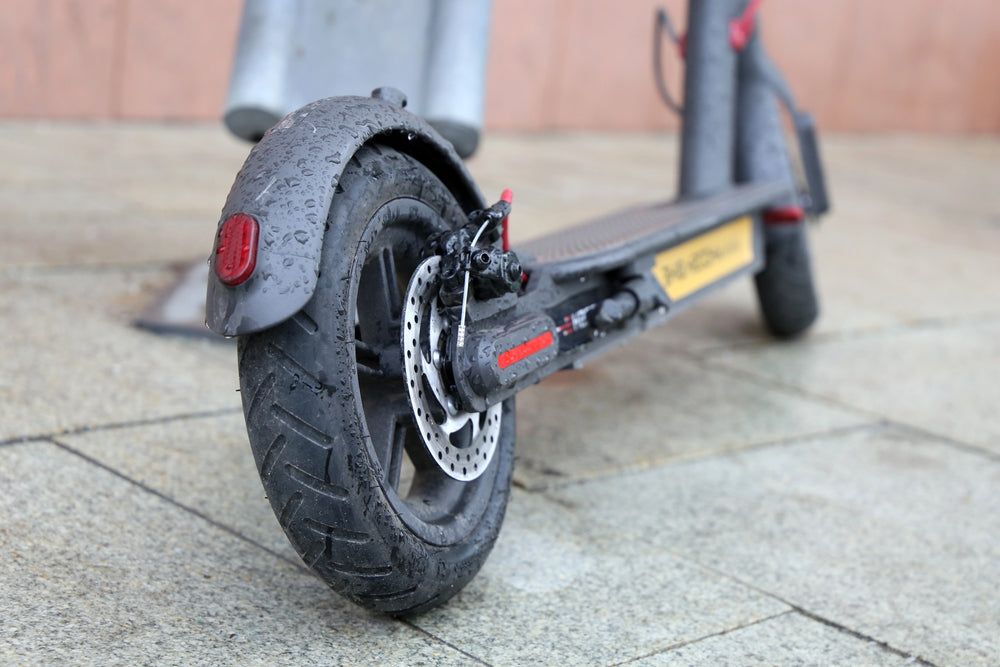
Riding E-Scooters Safely in Wet Weather
Riding an e-scooter is a fun and efficient way to get around, but wet weather can pose some challenges. Wet roads are slippery, visibility might be reduced, and the experience can become difficult or even dangerous without proper preparation. However, you can ensure a safe ride with the right knowledge and precautions.
Whether you’re a daily commuter or an occasional rider, knowing how to handle wet weather is crucial for making the most of your e-scooter. This guide will cover essential tips to keep you safe and secure and ensure your ride remains smooth, no matter the weather.
Understanding E-Scooter Weather Resistance
When riding an e-scooter in wet weather, understanding the scooter's Ingress Protection (IP) rating is crucial. This rating tells you how well-protected the scooter's components are against dirt and moisture. The IP rating consists of two digits: the first indicates protection against solid objects like dust, and the second against liquids. For instance, a rating of IP54 means essential protection against dust and mild water splashes, whereas an IPX6 offers a stronger shield against rain and even water jets.
Before hitting the wet roads, check your scooter's IP rating. Knowing this helps gauge your scooter's limits when exposed to moisture. Not all e-scooters are built to handle the same amount of water exposure. A scooter with a low IP rating might suffer from electrical issues if exposed to heavy rainfall, while a higher rating could endure more without trouble.
If your scooter’s rating isn't designed for wet conditions, it's best to avoid riding when it’s raining heavily. Riding safely involves respecting these ratings and ensuring your scooter remains reliable and functional. Awareness and preparation can go a long way in preventing potential damages and ensuring a smooth ride.
Essential Gear for Wet Weather Riding
Equipping yourself with the right gear is vital for a safe and comfortable ride during wet conditions. Start by investing in a good waterproof jacket and pants to keep you dry. These protect not only against rain but also from cold winds, keeping your focus sharp while riding.
Don't forget about your feet. Wet roads can become a hazard if your shoes have poor grip. Waterproof boots or shoes with non-slip soles are a smart choice. They offer better traction when braking or stabilising your scooter.
For added safety, consider a helmet with a visor to shield your face from rain and improve visibility. Gloves are another excellent addition, providing grip and warmth to control the handlebars.
Here's a quick checklist:
- Waterproof jacket and pants
- Non-slip waterproof footwear
- Helmet with visor
- Gloves for warmth and grip
Staying dry and comfortable helps you concentrate on the road, reducing distractions and making for a safer ride. Proper gear not only shields you from the weather but also boosts your confidence to tackle any challenge that comes your way.
Riding Techniques for Slippery Surfaces
Navigating slippery surfaces can be challenging, but you can ride safely and confidently with the proper techniques. When braking, it's essential to apply the brakes gently. Abrupt braking can cause skidding, which is particularly dangerous on wet roads. It's best to start braking earlier than usual and apply even pressure on both the front and rear brakes. This balanced approach helps maintain stability and reduces the risk of losing control.
During wet weather, focus on reducing speed before turns. Lower speeds offer more control and lessen the likelihood of sliding. Try standing with your knees slightly bent to absorb any bumps or irregularities on the road for extra stability. This positioning helps you adjust quickly to changes and keeps you steady.
Keeping a safe distance from other vehicles and obstacles is crucial. Wet conditions can double the stopping distance required compared to dry roads. This buffer zone allows you the necessary time to react appropriately. With these proactive techniques, your ride will be smoother, even in less-than-favorable weather.
Maintenance Tips for Your E-Scooter Post-Rain
After riding in the rain, it's essential to take some time to care for your e-scooter properly. Ensuring your scooter is dry and clean can prevent potential issues and keep it in top condition. Start by wiping your scooter with a dry cloth to remove excess moisture. Pay particular attention to electrical components and joints where water might collect.
Next, inspect and clean your brakes and tyres. Ensure that no debris has stuck to the wheels, and check that the brakes are functioning correctly before your next ride. If they feel less responsive than usual, adjust or replace them as needed to maintain safety.
A regular maintenance checklist can help you keep track:
- Dry the scooter thoroughly
- Check and clean brakes
- Examine and inflate tyres as needed
- Inspect the battery and connections
Regular post-rain maintenance ensures longevity and optimal performance for your scooter. It helps avoid wear and tear, keeping your rides safe and comfortable.
Conclusion
Riding an e-scooter in wet weather can be intimidating, but it can still be an enjoyable experience with proper preparation and techniques. Understanding your scooter's weather resistance, gearing up correctly, and practising safe riding techniques are crucial to ensure your safety and maintenance. By adopting these practices, you can confidently tackle wet conditions while protecting your e-scooter from unnecessary harm.
Visit Electric Scooter Shop and explore our selection of e-scooters designed with your safety and convenience in mind. Whether you are new to e-scooters or looking to upgrade, our range includes models perfect for wet weather, offering peace of mind and reliability year-round. Our team ensures you have a seamless and enjoyable riding experience, rain or shine.

Leave a comment